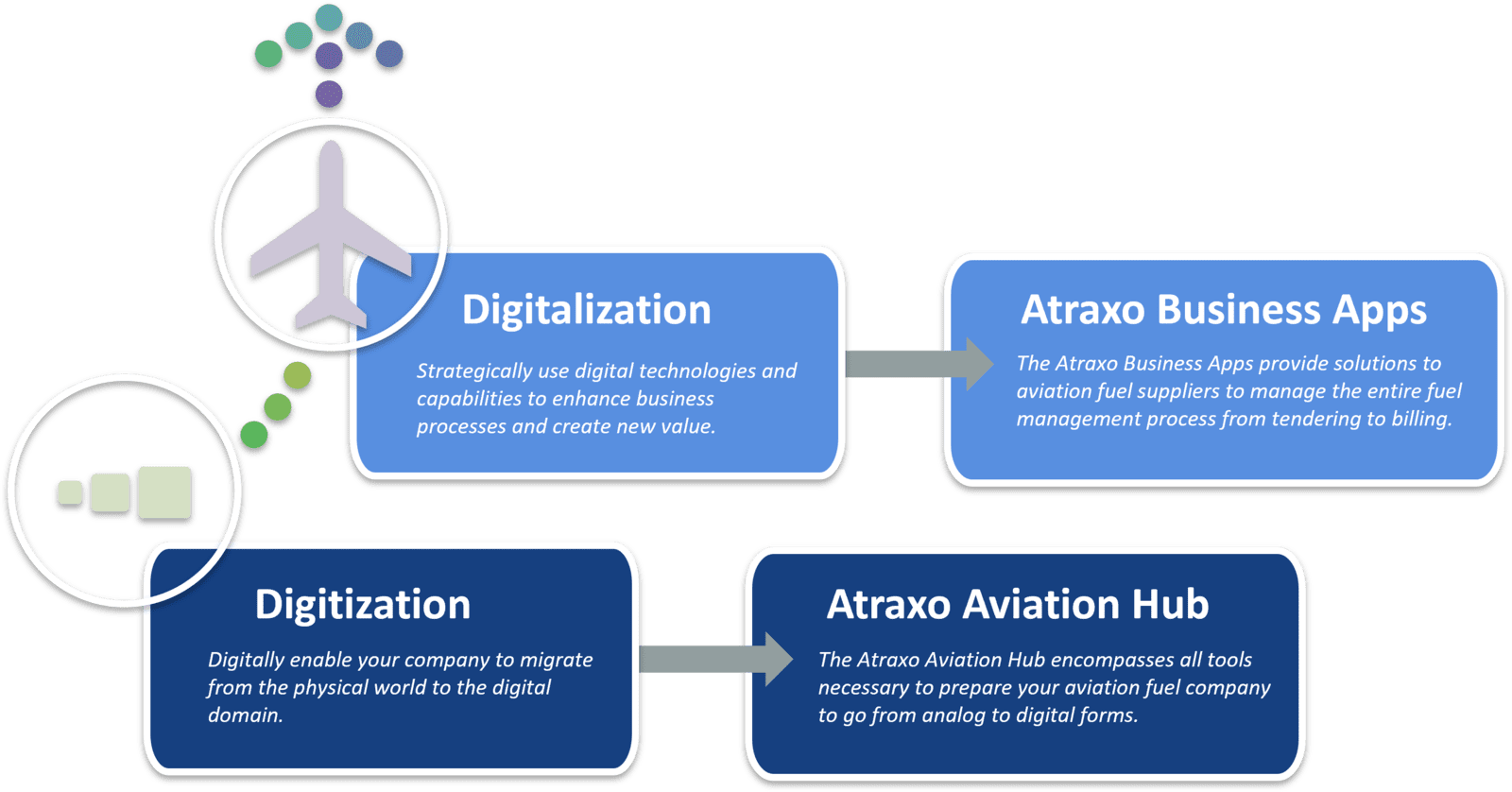Shift the conversation about digitalization from theory to action
The term "digitalization" has dominated discussions regarding the present and future of the aviation fuel landscape for decades. While there is a consensus that digital applications are essential for maintaining future competitiveness, there remains uncertainty about what digitalization truly entails and where its boundaries lie. This lack of clarity has left many companies struggling with the challenge of crafting a well-defined digital strategy that aligns with their unique needs and objectives.
Drawing from research by Gartner, we aim to embark on a blog series that introduces digital strategies, applies them to the aviation fuel industry, and demonstrates how Atraxo's solutions seamlessly integrate with your digital transformation endeavors.

Understanding Digital Strategies: Digitization and Digitalization
Research on digital strategies encompasses two fundamental concepts that hold particular relevance for the aviation fuel landscape: digitization and digitalization. To formulate a precise digital strategy, it's crucial to grasp the distinction between these concepts.
Digitization describes the process of changing from analog to electronic forms, also known as digital enablement. It encapsulates the necessary groundwork to enable the migration of processes from the physical world to the digital domain.
Digitalization encompasses the strategic use of digital technologies to enhance business processes and interactions. It is about using the tools and capabilities built up during the digitization process to optimize current business processes or pursue new value-adding activities.
Digital Strategies for the Aviation Fuel Industry
Digitization: Lay the Foundation
In the aviation fuel industry, static legacy IT systems are still widely in use. Communication channels are often established on an individual basis between business partners, and physical document exchanges persist without clear standards. This results in manual processes that are prone to errors. The first step to fixing this problem is to build up the necessary capabilities through digitization:
Capability to produce electronic documents (fuel tenders, tickets, invoices)
In the aviation fuel sector, the ability to generate electronic documents for tasks like bidding in fuel tenders, processing fuel tickets, and sending invoices electronically represents a significant advancement towards a more digitized and agile industry.
Capability to have these electronic documents in a standardized format (IATA XML format)
In the aviation fuel sector, having the ability to generate these electronic documents in the standardized IATA XML format is paramount, as it facilitates easy exchange of crucial information, streamlining processes and promoting industry-wide consistency. See also our blog article on Aviation Fuel Data Exchange made easy.
Capability to set up standardized communication channels with business partners (APIs, sFTP, web services)
In the aviation fuel sector, the ability to set up standardized communication channels through technologies like APIs, sFTP, and web services is instrumental in ensuring swift and reliable interactions with business associates, paving the way for enhanced operational efficiency and industry-wide cohesion.
Reducing internal IT spending by eliminating peer-to-peer data connections with business partners and adopting Software as a Service (SaaS) technology, which eliminates the need to own and operate IT infrastructure, can enhance operational margins.
Digitalization efforts extend to the workforce, benefiting sales, operations, and accounting teams. These improvements include better support for responding to fuel tenders, unifying customer tender forms, and generating contracts from awarded bids as well as automating operations and accounting tasks.
Improve customer experience (CX)
Implementing digital feedback channels for complaints, offering IATA XML data formats for invoices and tenders, and enabling customer self-service can significantly enhance CX.
Increase asset utilization
Integration of digital technologies can help optimize inventory management, providing better visibility into customer demand and improving asset productivity.
In this blog, we've taken a deep dive into the distinctions between digitization and digitalization within the aviation fuel industry. We've outlined where significant opportunities for improvement exist within the industry. As we've seen, digitization involves the transformation of analog processes into digital formats, setting the stage for more advanced digital strategies. Digitalization builds on that and encompasses the broader strategy of using digital technologies to transform business operations, enhance decision-making, and create value.
In our upcoming blogs, we'll delve even deeper into the intricacies of digitization and digitalization. We'll refine our insights with solutions provided by Atraxo, showcasing how these solutions can turn the potential for improvement into tangible results. So, stay tuned for more in-depth discussions on this exciting transformation happening in the aviation fuel industry.